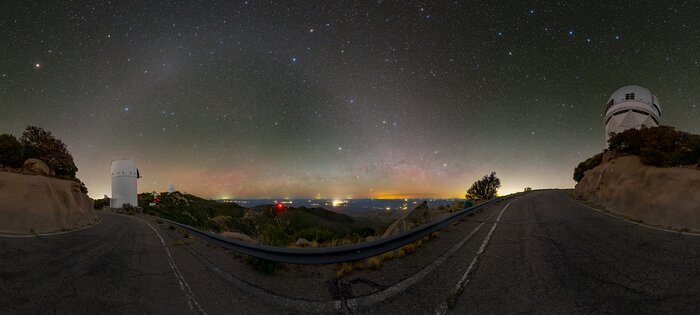Arches all around Kitt Peak
Home to over twenty optical and two radio telescopes, the U.S. National Science Foundation Kitt Peak National Observatory (KPNO), a Program of NSF NOIRLab, is located at the highest point on the Quinlan Mountain in the Arizona-Sonoran Desert on the Tohono O’odham Nation, southwest of Tucson, Arizona. On the right is the Nicholas U. Mayall 4-meter Telescope, which was the world’s second-largest telescope when it was built in 1973. On the left is the UArizona Bok 2.3-meter Telescope, operated by Steward Observatory at the University of Arizona.
KPNO’s distance from heavily light-polluted areas — like the cities and towns on the horizon — makes it an ideal place for observing faint astronomical objects. In this picture, the photographer has captured two phenomena that are difficult to observe in areas affected by heavy light pollution. First is the faint arcing glow in the sky known as zodiacal light. This light glow is created by interplanetary dust scattering sunlight. Second is the brightest spot of the arch, seen over the Bok telescope, known as the Gegenschein. This spot is also caused by sunlight reflecting off of dust in the outer part of the Solar System — and so the Gegenschein always appears opposite the Sun in the sky. The curving of the road and the zodiacal light band is an effect of the panoramic 180-degree photograph. Click on the little icon to move around the image.
This photo was taken as part of the recent NOIRLab 2022 Photo Expedition to all the NOIRLab sites. Tomáš Slovinský, the photographer, is a NOIRLab Audiovisual Ambassador.
Credit:KPNO/NOIRLab/NSF/AURA/T. Slovinský
About the Image
| Id: | iotw2427a |
| Type: | Photographic |
| Release date: | July 3, 2024, noon |
| Size: | 18000 x 8108 px |
About the Object
| Name: | Nicholas U. Mayall 4-meter Telescope, UArizona Bok 2.3-meter Telescope |
| Category: | Kitt Peak National Observatory |
